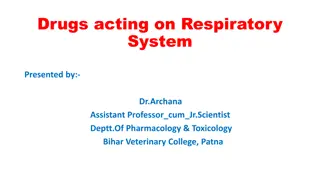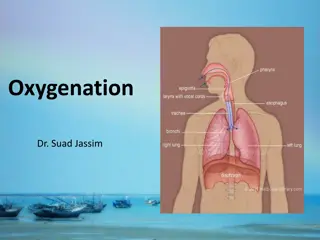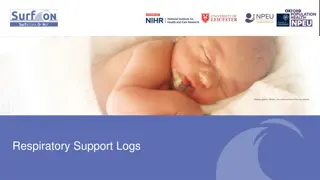Understanding Respiratory System: Lectures on Alveoli Stability, Compliance, and More
Dive into the complexities of the respiratory system with these enlightening lectures covering topics such as the stability of alveoli, lung compliance, airway resistance, surface tension, and the interdependence of alveoli. Gain insights into the factors affecting pulmonary ventilation and learn about the essential role of pulmonary surfactant in maintaining efficient breathing mechanics.
Download Presentation

Please find below an Image/Link to download the presentation.
The content on the website is provided AS IS for your information and personal use only. It may not be sold, licensed, or shared on other websites without obtaining consent from the author. Download presentation by click this link. If you encounter any issues during the download, it is possible that the publisher has removed the file from their server.
E N D
Presentation Transcript
Respiratory System Dr Archna Ghildiyal Associate Professor Department of Physiology KGMU
LECTURE :4 Contents: Stability of lungs & alveoli Compliance Resistance Surface tension Surfactant Work of breathing
Learning Objectives Factors contributing to stability of alveoli Surfactant- Secretion,Composition,Function Work of breathing Applied
Stability of Lungs Two forces hold the thoracic wall and the lungs in close opposition: 1. Intrapleural fluid cohesiveness: -Water molecules in the intrapleural fluid are attracted to each other -Pleural membranes tend to stick together.
Contd 2. Negative intrapleural pressure: -Transmural pressure gradient -Lungs are forced to expand outwards Factors that stabilize alveoli Pulmonary surfactant Mechanical interdependence
Mechanical/Alveolar Interdependence keeps the alveoli open If an alveolus start to collapse Surrounding alveoli are stretched and then recoil Exert expanding forces in the collapsing alveolus to open it
Factors Affecting Pulmonary Ventilation Lung compliance Airway resistance Surface tension
Lung Compliance Extent to which the lungs expand for each unit increase in transpulmonary pressure Total compliance of both lungs together in normal adult: 200 ml of air per cm of water transpulmonary pressure
Contd Tissue elastic forces = represent 1/3 of total lung elasticity Fluid air surface tension elastic forces in alveoli = 2/3 of total lung elasticity.
Contd Two Curves: Inspiratory compliance curve Expiratory compliance curve The total work of breathing of the cycle is the area contained in the loop.
Transpleural pressures required to expand normal lung = 3x pressure to expand saline filled lung.
Airway Resistance Walls of airways offer some resistance to normal airflow in and out of lungs Degree of contraction or relaxation of smooth muscle of airway-regulates airway diameter and resistance
Contd Resistance to flow in the airway normally is very low Primary determinant of airway resistance is the radius of the conducting airway Parasympathetic stimulation causes bronchoconstriction(vagus-Ach)
Sympathetic stimulation Causes Bronchodilatation Direct via nerves-relatively weak effect Adrenal medulla hormone-mainly epinephrine via -adrenergic receptors
Surface Tension Causes alveoli to assume the smallest possible diameter Accounts for 2/3 of lung elastic recoil- size of alveoli during expiration Must overcome to expand the lungs during each inspiration (Compliance/Elastic work of breathing)
Surfactant Reduces the Alveolar Surface Tension LaPlace s Law Assume alveoli as spherical bubbles, then: 2 T = P r P = Collapsing pressure (Directed Inward) T = Surface Tension r = Radius of the bubble
Surfactant Complex mixture of Phospholipids,Proteins & Ions Main phospholipid Dipalmitoylphosphatidylcholine(DPPC) Produced by Type II alveolar epithelial cells Lipids form a monolayer at the air-water interface
Protein Components Hydrophilic (SP-A and SP-D) Immune functions(Opsonization) Transport to alveolar surface Hydrophobic (SP-B and SP-C) Monolayer adsorption and fluidity
Formation and secretion of Surfactant N-Nucleus SF-Surfactant CM-composite body. LB-lamellar bodies TM-Tubular myelin
RDS(Respiratory Distress Syndrome) Acute disease of newborn Decreased Surfactant Greater the surface tension Harder for the oxygen to get into the blood Lower pulmonary ventilation.
Work of Breathing Work of inspiration 3 fractions: Compliance/elastic work Tissue resistance work Airway resistance work Energy required for respiration/pulmonary ventilation: -Quiet respiration:3-5% of total energy expanded by the body -Heavy exercise: can 50 fold
Increased Work of breathing When : Pulmonary compliance Airway resistance Elastic recoil Need for ventilation
References Guyton & Hall.Text book of Medical Physiology Ganong s Review of Medical Physiology Berne & Levy Physiology meded.usd.edu
Question:1 As alveolar size decreases transmural pressure: A. Decreases B. Increases C. May go up or down depending on the presence of or absence of surfactant D. Is static due to radial traction from surrounding connective tissue and alveoli
Question:2 Which of the following increases during strenuous breathing: A. Compliance B. Airway Resistance C. Tissue Resistance D. Surface Tension
Question:3 Pulmonary vascular resistance: A. is greater in the lung during maximal inspiration rather than expiration B. is about 1/10 that of systemic circulation C. will decrease in poorly ventilated areas D. is not affected by sympathetic nervous system
Question:4 Alveolar surfactant acts to INCREASE pulmonary: A. Surface tension B. Surface area C. Compliance D. Airway resistance
Question:5 What will happen if the lungs loose their elasticity? A.Chest wall expands and become barrel shaped B. Lungs Collapse C. FRC Decreases D. Vital Capacity Increases
Answers 1- B 2- B 3- B 4-C 5- A























